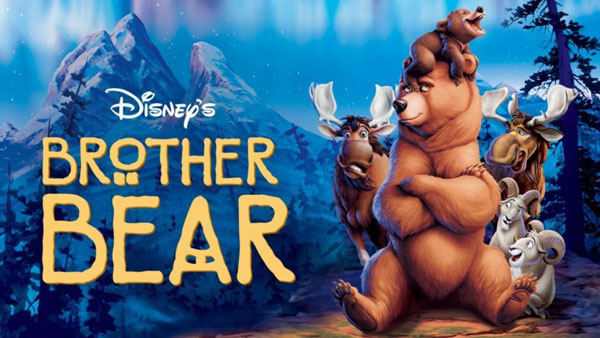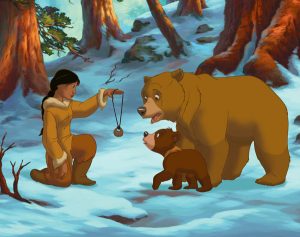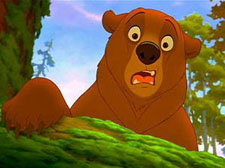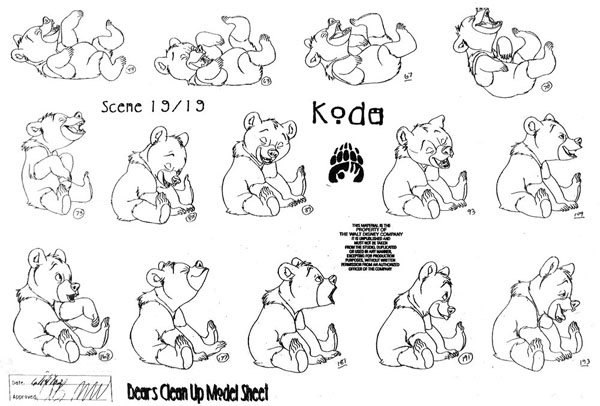
Suspended Animation #317
When I worked at Walt Disney World, one of my roles was to teach two classes to interns at Disney Feature Animation Florida. Because of my performing background I taught “Acting for Animators” and because of my animation history background I taught an eight session class on the “History of Animation” that focused on non-Disney animation from silent films to the year 2000.
 As a result, I also got to attend some special presentations at the studio including one in late September 2003 where producer Chuck Williams and directors Aaron Blaise and Bob Walker talked about their work on the animated feature Brother Bear (2003), one of the last hand-drawn Disney animated films and also the last animated feature primarily made by the Florida studio. Very little has been written about this film that is generally considered a minor offering in the Disney universe.
As a result, I also got to attend some special presentations at the studio including one in late September 2003 where producer Chuck Williams and directors Aaron Blaise and Bob Walker talked about their work on the animated feature Brother Bear (2003), one of the last hand-drawn Disney animated films and also the last animated feature primarily made by the Florida studio. Very little has been written about this film that is generally considered a minor offering in the Disney universe.
While primarily traditionally animated, some scenes like the salmon run and caribou stampede utilized computer generated artwork. The artists did life drawing sessions with live bear cubs but were also taken to the nearby Fort Wilderness Resort and Campground at Walt Disney World for drawing sessions three times a week for two months.
The two goofy bull moose, Tuke and Rutt, were voiced by comedians Rick Moranis and Dave Thomas who had created the characters of the Canadian brothers Bob and Doug MacKenzie for the sketch comedy show SCTV in 1980. They used those same personas for the moose.
After Kenai is transformed into a bear the film shifts from a 1.75:1 aspect ratio to the CinemaScope ratio of 2.35:1 to give the audience a sense of seeing the world differently. Songwriter Phil Collins wrote a ‘transformation song” that was translated into Inuit and then sung by a full Bulgarian choir. It was cut from the film.
The background and layout artists studied the work of landscape artist Albert Bierstadt, a personal favorite of then Disney CEO Michael Eisner. Eisner had just bought a large Bierstadt painting and wanted to do a movie that captured the look and feel of that painting and so put Brother Bear into production.
As always, I tried to take good notes since I knew Disney would not document this limited audience presentation and that once again, I was lucky to be in the right place at the right time.
Aaron Blaise: We took two trips to research bears in their natural habitat. Chuck and I went with two of our story guys to Alaska and visited some of the places with the highest concentrations of grizzly bears in the world. We went back there again the following year with Bob, along with our head of layout, our art director and other key visual artistic people.
We also traveled through Wyoming on that trip and later to the National Parks in California. We tried to take the best of North America and boil it down to one perfect, idealistic North America for the movie.
 Bob Walker: We flew into this one place, Geographic Harbor in Alaska, and from the air we could see twenty or thirty bears. But once we landed and walked up to where they were, they all scattered. They’re actually really shy. We ended up sitting around there for a couple of hours just kind of hanging out and hoping for one or two to come out.
Bob Walker: We flew into this one place, Geographic Harbor in Alaska, and from the air we could see twenty or thirty bears. But once we landed and walked up to where they were, they all scattered. They’re actually really shy. We ended up sitting around there for a couple of hours just kind of hanging out and hoping for one or two to come out.
A couple of hours later, a big, huge male who must have been 700 or 800 pounds just came walking down the river. He eventually came to within six or seven feet of us. He didn’t really pay much attention to us but when you see that thing coming right at you, it’s pretty scary.
Blaise: There were several encounters. We had a bear come through our campsite one night and with Chuck’s experience, we were hiking up a hill just kind of talking and couple of us looked up and saw a mother grizzly with two cubs about 30 yards ahead of us. Chuck’s still talking, walking along and, had we not said anything, he would have walked right into them.
Chuck Williams: Disney films like Bambi, The Jungle Book, The Lion King deal with some heavy issues of life and death. They all have moments where the central character is faced with death and what that means. You’ll find that true in our story as well. So those stories kind of paved the way for us to deal with some important themes and drama.

Blaise: We had done a couple of bear story treatments that weren’t really landing. Thomas Schumacher who was head of our division at the time suggested that we go off and just really research different bear legends and myths from around the world.
We discovered some great native myths from North America that had to do with transformation into the human and animal worlds. Their belief was that we’re all people; we just have different skin. There were also some emotional stories that we kind of attached ourselves to, so we started putting all of that together and came up with our initial transformation story.
 Williams: Most good stories are about transformation. A character is changed or transformed by the course of events in a story. We thought it was a great metaphor to have Kenai transformed physically and then by the end of the film transformed emotionally as well.
Williams: Most good stories are about transformation. A character is changed or transformed by the course of events in a story. We thought it was a great metaphor to have Kenai transformed physically and then by the end of the film transformed emotionally as well.
Blaise: The story became about three brothers and in a way we relate to each other in that way as well. We’ve been together on this film for six years. Actually, we all started at the Florida studio on the same day fifteen years ago.
On our research trips, we lived in an RV together for weeks at a time. That can test you, and we really got along great. Plus, we each have brothers so we were able to draw on a lot of that in making this film.
Walker: We knew our movie was very dramatic right from the start and we knew we wanted these two dumb Canadian moose to provide relief from all of the drama and tension. At first, they were only comic relief and we were having trouble making them part of the twists and turns of the story.
Ultimately though, their brotherhood especially in the final scene of the movie really plays a big, pivotal role. The film will make people cry. It’ll make them laugh.
Blaise: Dave Thomas, the voice of Tuke, saw it and said, “This is the kind of movie that makes the world a better place.” The theme of the movie is to let love guide your choices. If you do that, nothing can go wrong.


 Jim Korkis is an internationally respected animation historian who in recent years has devoted his attention to the many worlds of Disney. He was a columnist for a variety of animation magazines. With his former writing partner, John Cawley, he authored several animation related books including The Encyclopedia of Cartoon Superstars, How to Create Animation, Cartoon Confidential and Get Animated’s Animation Art Buyer’s Guide. He taught animation classes at the Disney Institute in Florida as well as instructing classes on acting and animation history for Disney Feature Animation: Florida.
Jim Korkis is an internationally respected animation historian who in recent years has devoted his attention to the many worlds of Disney. He was a columnist for a variety of animation magazines. With his former writing partner, John Cawley, he authored several animation related books including The Encyclopedia of Cartoon Superstars, How to Create Animation, Cartoon Confidential and Get Animated’s Animation Art Buyer’s Guide. He taught animation classes at the Disney Institute in Florida as well as instructing classes on acting and animation history for Disney Feature Animation: Florida.




















































I’d have liked to audit your Acting for Animators class. The Disney presentations on the subject that I’ve seen all seem to involve Ward Kimball making silly faces at the mirror on his desk, and little else.
Geographic Bay is on the coast of Katmai National Park on the Alaska Peninsula. The world’s highest concentration of brown bears can be found during the July salmon run at a place in that park called Brooks Falls, on a short river connecting two lakes. The salmon run scene in Brother Bear is clearly inspired by that location. The luxury lodge with the viewing platforms and gourmet dining room hadn’t yet been built when I was there, but Blaise, Walker and Williams would have enjoyed those amenities.
Across the Cook Inlet from Katmai National Park is the Kenai Peninsula, after which the hero of Brother Bear was named. I went there mainly for the bird watching and didn’t see a single bear, but apparently both brown and black species are resident there.
Now if only a Bulgarian choir would record an Inuit translation of “Sussudio”….
My Acting for Animators classes were fun but frustrating. Many animators are very shy and only act and interact through their pencils. Primarily the class helped them understand about how to develop a character and how that influences movement, how to open themselves up to responding to another character and how a character can change a storyline. It gently forced them to open up more.
So there was a lot of theater games, improvisation and something I often used when I was teaching drama to very young children (I have taught multiple theater classes to students ranging from pre-school to college. I have directed over 236 different stage productions and acted in over three times that number) where I would tell a story, break them up into groups and each group had to act and re-tell the story. It was great to see the differences and what things each group chose to emphasize or ignore.
I wish it had occurred to me at the time to write a book but apparently another drama did write a book with that same title.
This was such a joy to work on.
I remember being at one of those screenings. It was the last event of this kind I was ever able to bring my father to before he passed away in 2004. I saved the plastic popcorn tub, even though our dog chewed it, because it reminds of how excited he was to be there.
Aside from being a perfectly grand film which, as was the case with several films of the era, suffered under comparison to The Lion King especially at the box office, Brother Bear had a magnificent score by Phil Collins and Mark Mancina.
In the theater, the moment I heard:
“Welcome to our family time
Welcome to our happy to be time
This is our festival
Ya know the best of all
We’re here to share it all”
I leaned forward and whispered to our Vice=President of Creative Advertising that this could be a great song for the theme parks and she nodded. I still think so.
I remember going back to see Brother Bear again in a theater with the rest of the family, then getting the DVD. It truly stands alongside the finest of Disney films.
A nice litter animated feature film. It’s a shame it was one of the last traditional animated films from Disney (aside from the two when the studio was renamed Walt Disney Feature Animation) before it switched to CGI. It earned the “Best Animated Feature Film” nomination but it of course lost to Piaxr’s “Finding Nemo” (which was also distributed by Disney and before Pixar became a sister studio).
I’m hoping for a traditional animated revival again for Disney sooner or later. I think audiences want some sort of different “new look” for animated feature fair .
The thing is, there is still a market for traditional animation. Heck, Japanese Anime is bigger than ever and the vast majority of it uses traditional animation (combined with CG for certain things.) One of the top grossing films of the past couple of weeks in the U.S. is the Demon Slayer film, which primarily uses traditional animation. It’s the highest-grossing film in Japan ever. Now, I’m not saying that Demon Slayer is on the same level creatively as the best animated films of all time, but it does show that people are still happy to pay to see traditional animation in the theaters. 3D CG animation is certainly a valid medium and I’ve seen some remarkable work made using it, but 2D animation also has its own set of aesthetic advantages that can’t be duplicated in 3D CG. I just wish that the big studios hadn’t gone all-in on 3D CG, rather than choosing the best medium for the particular story being told. There is space for both.
By 2003, I was largely wrapping up my long freelance illustration gig with Disney Theme parks, so didn’t know much about this film. Took my six-year-old to see it and we both loved it. I was honestly surprised by the plot twist and the emotional range of the film. It was, dare I say it, Dumbo-like in its simple tale, told simply well.
And watching the trailer again reminded me how much hand-drawn animation is an art and craft unlike any other.